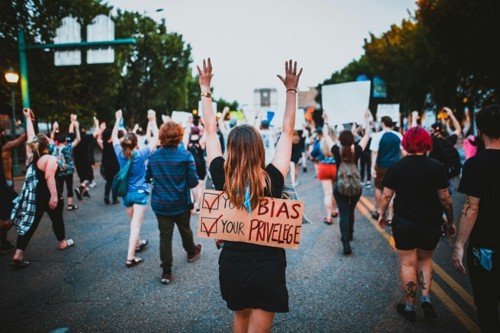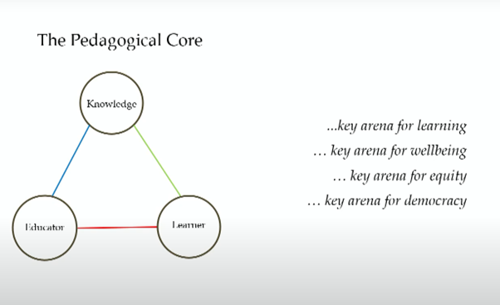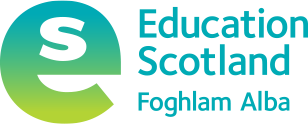Global voices, Scottish classrooms: exploring themes in education: Theme 2: Education as social movement
This theme revolves around looking at education as a part of the wider picture of how society functions.
It offers a variety of activities designed to help educators consider their professional values and beliefs and how these play out in their practice.
Have the following images printed out or up on a screen for people to see:

(Person holding a cardboard sign that says Fight today for a Better Tomorrow)

(Protesters walking away from camera. On one persons back is the sign that says: check your bias, check your privilege)
See/think/me/we activity
(This activity takes approximately 15 minutes)
This Making Thinking Visible Routine should be completed individually to kick-start the group’s thinking:
-
See: Look closely at the images, what do you notice? Make lots of observations
-
Think: What thoughts/questions do you have about the images?
-
Me: What connections can you make between you and the images?
-
We: How might the images be connected to bigger stories—about the world and our place in it?
Invite individuals to feedback on their reflections should they wish to.
After the connector activity please watch the following two clips, asking individuals to make their own notes as necessary:
37:20 - 50:23 of Dr Santiago Rincón-Gallardo’s keynote
29:02 – 30:24 of Dr Pak Tee Ng’s Keynote
In Dr. Rincón-Gallardo’s keynote he discusses the ‘Pedagogical Core’ of education and how the relationships and activity in this field can nurture the 4 fundamental components of ‘a better world’: Learning, well-being, equity and democracy.
The Pedagogical Core (shown in the image from the presentation) is the connection between learner, educator and knowledge.

Santiago describes the arena of equity as leading to the humanisation of education – whereby everyone involved are seen as a full, equal and worthy human beings. From here, this allows the relationships, systems and spaces that are cultivated in the pedagogical core to be democratic and characterised by mutual learning, influence and dialogue.
In simpler terms, Dr. Rincón-Gallardo’s advocates for learning spaces that move beyond the traditional power dynamics. Instead of a rigid, educator-controlled environment, he advocates for a space of reciprocal learning and openness. In this space, both educators and learners bring their own unique knowledge.
Think/feel/care activity
(This activity takes approximately 15 minutes, 5 minutes individually and 10 minutes to share)
The following Making Thinking Visible routine: Think, feel, care – should support educators to break down Santiago’s point of view and help relate it to their own:
-
Think: What are your thoughts on Santiago’s view of education and your role within it?
-
Feel: How does Santiago’s position make you feel as an educator?
-
Care: What would you say are Santiago’s values, priorities, or motivations with regards to education? What is important to him and does it mirror or conflict with your own beliefs?
Dr. Santiago Rincón-Gallardo goes on to define social movements as, ‘the vehicle society has designed to change culture’. He goes on to apply this definition to education in that the goal should not be to compartmentalise and scientifically manage education by focussing on the embedding of a particular policy, resource or knowledge base but focussed on collectively triggering and sustaining widespread societal change by challenging status quo through pedagogy.
He notes the main differences as:
|
|
Scientific Management |
Social Movement |
|
Leadership |
Hierarchical |
Networked, distributed |
|
Core Values |
Achievement, efficiency, control |
Learning, efficiency, democracy |
|
Core Practices |
Prescription, mandates, external accountability |
Dialogue, deliberation, internal accountability |
|
Relies On |
External incentives, resources |
Intrinsic motivation, resourcefulness |
|
Stance on Change |
Incrementalism, stability |
Radical innovation, cultural renewal |
The 4 C’s activity
(This activity will take approximately 20 minutes- 10 minutes in groups of 4 and 10 to share)
These prompts will allow individuals to consider the definition of education as a social movement and how this relates to their own practice and setting but also how this then connects to the wider picture of the education system as a whole:
-
Connections: What connections can you see between your own practice, the practice of your school/setting and the idea of education as a social movement?
-
Challenges: What ideas, positions or assumptions do you wish to challenge or disagree with when thinking about education as a social movement?
-
Concepts: What key ideas and principles do you agree with when thinking about education as social movement?
-
Changes: What changes in attitudes, thinking, or action would be needed by you and others (other educators, parents, society, government etc) to fully realise education as social movement?
Once the small groups have had the opportunity to discuss the 4 C’s and make their own notes, there should be a whole group sharing session. The activity facilitator should summarise common themes that emerge from across the groups.
In his keynote, Dr Pak Tee Ng agrees with Dr. Rincón-Gallardo’s idea of education being the springboard of societal change,
‘Education is the human enterprise of paying it forward. One generation pays the price so that the next generation has a chance in life. Someone paid for us. Now it is our turn to pay it forward’
Opinion line activity
(This activity takes approximately 10 minutes)
Put this quote where it is visible for everyone to see (flipchart or on a screen) - then ask practitioners to place themselves along a continuum of strongly disagree to strongly agree.
Once situated, ask educators to feedback on why they have placed themselves where they have, reminding them that there is no right or wrong answer- simply their own opinion.
Invite educators to ask each other questions about their positions in an open-minded and respectful manner.
Quiet reflection activity
(This activity takes approximately 5 minutes)
Finally, take 5 minutes of quiet reflection to think about your current practice – in what ways do you currently ‘pay it forward’, can you think of a recent example – how this felt and the impact it had?
Hooks, B. 1994. Teaching to transgress: Education as the practice of freedom. New York: Routledge.
Ng, P. T. 2017. Learning from Singapore: The Power of Paradoxes. Singapore: World Scientific Publishing Company.
The New School. 2014. "Teaching to Transgress Today: Theory and Practice In and Outside the Classroom". [YouTube video] [Accessed 3 September 2024].
Infed.org Paulo Freire: dialogue, praxis and education (URL links to specific article) [Accessed: 3 September 2024]
Freire, P. 1968 Pedagogy of the Oppressed; Brazil [YouTube Audiobook] [Accessed: 3 September 2024]
This theme has helped connect educators to the notion of education as a social movement. In theme three we will consider how we proactively work as an education system to create the change we want to see.
